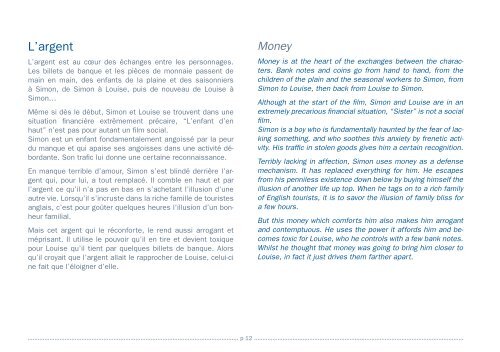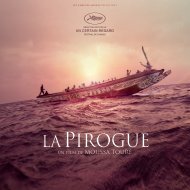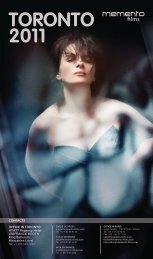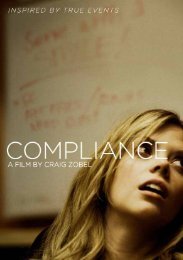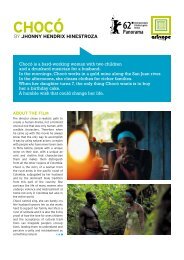Press kit - Memento Films International
Press kit - Memento Films International
Press kit - Memento Films International
You also want an ePaper? Increase the reach of your titles
YUMPU automatically turns print PDFs into web optimized ePapers that Google loves.
L’argent<br />
L’argent est au cœur des échanges entre les personnages.<br />
Les billets de banque et les pièces de monnaie passent de<br />
main en main, des enfants de la plaine et des saisonniers<br />
à Simon, de Simon à Louise, puis de nouveau de Louise à<br />
Simon…<br />
Même si dès le début, Simon et Louise se trouvent dans une<br />
situation financière extrêmement précaire, “L’enfant d’en<br />
haut” n’est pas pour autant un film social.<br />
Simon est un enfant fondamentalement angoissé par la peur<br />
du manque et qui apaise ses angoisses dans une activité débordante.<br />
Son trafic lui donne une certaine reconnaissance.<br />
En manque terrible d’amour, Simon s’est blindé derrière l’argent<br />
qui, pour lui, a tout remplacé. Il comble en haut et par<br />
l’argent ce qu’il n’a pas en bas en s’achetant l’illusion d’une<br />
autre vie. Lorsqu’il s’incruste dans la riche famille de touristes<br />
anglais, c’est pour goûter quelques heures l’illusion d’un bonheur<br />
familial.<br />
Mais cet argent qui le réconforte, le rend aussi arrogant et<br />
méprisant. Il utilise le pouvoir qu’il en tire et devient toxique<br />
pour Louise qu’il tient par quelques billets de banque. Alors<br />
qu’il croyait que l’argent allait le rapprocher de Louise, celui-ci<br />
ne fait que l’éloigner d’elle.<br />
Money<br />
Money is at the heart of the exchanges between the characters.<br />
Bank notes and coins go from hand to hand, from the<br />
children of the plain and the seasonal workers to Simon, from<br />
Simon to Louise, then back from Louise to Simon.<br />
Although at the start of the film, Simon and Louise are in an<br />
extremely precarious financial situation, “Sister” is not a social<br />
film.<br />
Simon is a boy who is fundamentally haunted by the fear of lacking<br />
something, and who soothes this anxiety by frenetic activity.<br />
His traffic in stolen goods gives him a certain recognition.<br />
Terribly lacking in affection, Simon uses money as a defense<br />
mechanism. It has replaced everything for him. He escapes<br />
from his penniless existence down below by buying himself the<br />
illusion of another life up top. When he tags on to a rich family<br />
of English tourists, it is to savor the illusion of family bliss for<br />
a few hours.<br />
But this money which comforts him also makes him arrogant<br />
and contemptuous. He uses the power it affords him and becomes<br />
toxic for Louise, who he controls with a few bank notes.<br />
Whilst he thought that money was going to bring him closer to<br />
Louise, in fact it just drives them farther apart.<br />
Une cartographie imaginaire<br />
Même si “L’enfant d’en haut” est le désir de faire après<br />
“Home” (fable contemporaine sur la famille et le monde) un<br />
film totalement ancré dans le réel, c’est-à-dire dans des décors<br />
existant, j’ai eu envie que cette station de ski et sa vallée<br />
ne soient pas identifiables par le spectateur. L’espace dans<br />
lequel l’action se déroule est ainsi constitué d’un ensemble de<br />
différents lieux rassemblés dans une cartographie imaginaire.<br />
Il y a dans “L’enfant d’en haut” une approche esthétique sur le<br />
parcours balisé des vacanciers des stations de ski, toujours en<br />
mouvement (téléphériques, télésièges…), en contraste avec le<br />
parcours non balisé du bas, celui de Simon qui coupe à pied à<br />
travers champs, la plaine étant devenue au fil des années le lieu<br />
de passage qui mène aux stations. Cette plaine industrielle ne<br />
donne qu’une seule envie à Simon, une seule tentation : lever la<br />
tête en direction des montagnes et monter, encore et encore…<br />
An imaginary cartography<br />
After “Home”, which was a contemporary fable about a family<br />
and the world, “Sister” represents a wish to make a film that<br />
is totally anchored in the real, in this case real locations. That<br />
said, I wanted the ski resort and the valley below not to be<br />
identifiable by the viewer. The space in which the action takes<br />
place is therefore made up of a number of different locations<br />
brought together according to an imaginary cartography.<br />
There is an aesthetic approach in “Sister” built around the<br />
marked pathways of the tourists in ski resorts, who are always<br />
in movement (cable cars, chairlifts, etc). This is in contrast<br />
with the unmarked routes down below, where Simon cuts<br />
across fields on foot, the plain having become over the years<br />
a place to pass through leading to the resorts. This industrial<br />
plain inspires only one thing in Simon, one single temptation:<br />
to look up at the mountains and to climb, higher and higher...<br />
p 12 p.13


